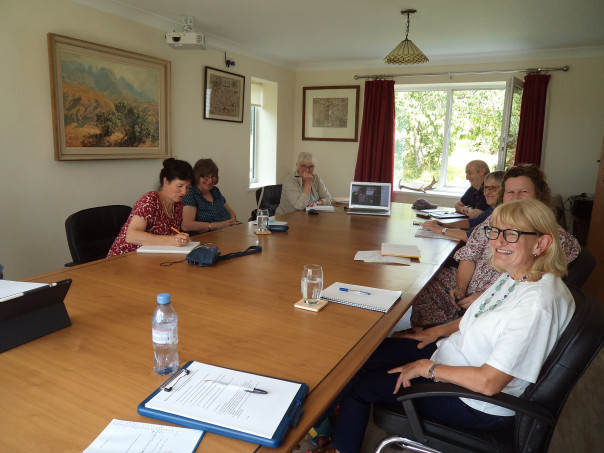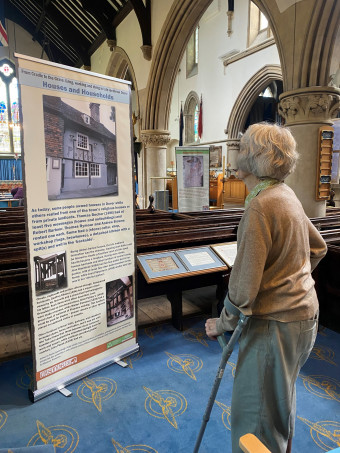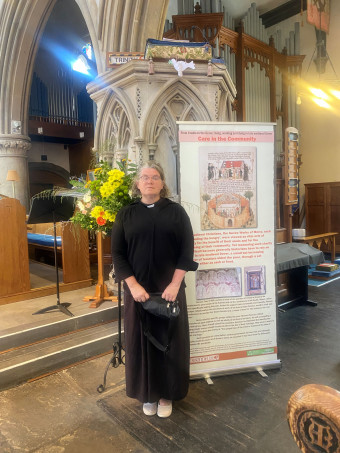After the excitement of Michael Wood, it is a more local focus this week, but hopefully no less interesting for that. Consequently, before I come to the exhibition and workshops at Dover, I thought I would mention St Mildred’s church in Canterbury last Saturday, the launch of the Aphra Behn project at Canterbury Christ Church on Wednesday, the Lossenham project meeting at Newenden this Thursday, and that Dr Diane Heath has been away on a research trip this week to the British Library and the Bodleian. Furthermore, there is still time to book to hear my talk on ‘Eastbridge, Pilgrimage and Late Medieval Canterbury’ which is due to take place at Eastbridge Hospital on Thursday 27 July at 3pm, to be followed by refreshments. For tickets, please call in at Eastbridge or phone 01227 471688.

Working through these chronologically, to mark the feast day of St Mildred (13 July), her church in Canterbury had a festival last Saturday where those attending were treated to a variety of sacred and secular songs from the Ukrainian choir that meets in St Peter’s church, followed by an organ recital by Professor Stephen Banfield. After this excellent morning, we were given a great guided tour of the architectural features of the church – from its early 11th-century beginnings up to the building of the At Wood chantry chapel on the eve of the Reformation from Professor Paul Bennett (recently retired Director of Canterbury Archaeological Trust and Visiting Professor of Archaeology in the Centre for Kent History & Heritage at Canterbury Christ Church University). As Paul said, this was by far the biggest group he had ever taken around a historic building. The final session of the day was given by the Rev. Dr Lesley Hardy on St Mildred and her place within the Kentish royal family which was enthusiastically received. To cap it all, as always, the refreshments provided were excellent and everyone felt it had been a great day, so thanks to the Rev. Jo Richards and the team at St Mildred’s church and hopefully this will be an annual event.
Although I wasn’t able to make it because of another meeting, it is great to be able to record that following the success of the application to the AHRC for a follow-up project on Aphra Behn, there was a celebration at the university’s St Martin’s Priory on Wednesday, which I understand went very well. Dr Astrid Stilma is the lead academic on this at CCCU and it will be interesting to see how this large collaborative project develops over the next couple of years, including, I understand, an international conference to be held at the University of Kent, another of the partners.
Coming to Thursday, it was one of the in person Lossenham Project wills group meetings at Lossenham. This time we tried bringing in some of the group online but we hit some wifi problems linked to topographical issues. However, half of the 18 strong group were there in person, and we had a very productive meeting. For as well as sorting out the dates of subsequent meeting up to and including November, our next meeting at Lossenham, we were able to thank Sophie Ogilvie officially for all of her hard work on the wills database and helping with transcription and translation questions among other things. So we wish her well in her new home just over the border into Wales, and she has said that she will continue to be involved with the group. Jason Mazzocchi has taken over from Sophie and they are working together through this transition period to make things as smooth as possible.

We then moved on to discuss progress regarding the group’s exploration of what there is beyond wills for ‘our’ parishes in the Kent and East Sussex County Record Offices. East Sussex is somewhat of a new venture, and we are very grateful to Sara Spratt for visiting the archives to see what they hold. She is going to put her findings into a table and pass them to Sue Muddiman to add them to the group’s Google Drive. This took us on to thinking about the way forward for the group, and here I’ll just mention some of the items Sue Hatt brought to our attention concerning her work with Tenterden Museum. For this link has been highly fruitful for both the wills group and the museum, especially recently regarding the museum’s work to illustrate what the houses and households in Tenterden would have been like in Tudor times. Nor is this confined to the messuages in the town because there are several what might have been labelled mansion houses in Tudor times in Tenterden’s hinterland. Thus, building styles and materials, as well as material culture more broadly have been key to the museum’s exhibitions this year and looking forward to 2024. Following on from Sue’s assessment, several members of the group offered further ideas that she and the museum might explore, such as shipbuilding and the Brykenden family from Keith Bailey, and Celia Jennings mentioned that she has recently transcribed the inventory of a dyer that would enhance the research on textiles – their manufacture and use. While keeping with material culture, Diane Thomas and Dr Rebecca Warren highlighted a new project coming out of the University of Exeter that is intended to explore this topic through wills which might in time offer some useful comparative resources. In this context, a study of inventories from the same group which resulted in Production and Consumption in English Households 1600-1750 (2004) which featured a comparative study between Kent and Cornwall might prove useful. Equally, although for another topic, the REED volumes regarding an exploration of Tudor entertainment and drama that might help in the context on Henry VIII’s visit to Halden Place. Thus, we had a very fruitful discussion and after the meeting concluded, as usual those present enjoyed a great lunch provided by Bridget Goodwin.

Now to the main event for this week’s blog, the temporary exhibition and three workshops at St Mary’s church in Dover in association with the ‘Kent’s Maritime Communities’ project coming out of a funded collaboration between Dr Craig Lambert at the University of Southampton and me at CCCU. So as part of celebrating Dover’s maritime past, present and future, we set up the six pop-up banners around this gem of a medieval church on the following topics: Supporting the Saints; Care in the Community; Merchants and Mariners; Fishing and Fishermen; Pilgrims and Passengers, and Houses and Households. To accompany this exhibition, entitled: ‘From Cradle to the Grave: Living, Working and Dying in Late Medieval Dover’, there is a free leaflet with more information which visitors can take away, do take a copy. Volunteers are on hand in the morning up to 1pm at St Mary’s church, so if you are nearby, please do visit the church and exhibition. Initially, it was only going to be up for 10 days, but now will be staying for August. Please do sign the church’s visitors book and there is a second book for your comments on the exhibition as we welcome feedback. Furthermore, I would like to thank the Rev. Catherine Tucker and her team at St Mary’s church for hosting these events, much appreciated.

Linked to this, Kieron Hoyle and I held three free workshops on ‘Working with Wills’ that were for beginners or those with limited experience of working with such historical documents, especially from the late Middle Ages (late 15th and early 16th centuries). In addition to the practical elements such as learning about different letter forms, the lack or complete absence of punctuation, different dating conventions, the use of Roman numerals and the relatively widespread use of a range of contractions and abbreviations, we worked together through reading a will for someone from Dover from the late 15th century. All of this was done in a spirit of co-operation so that it was very much a collaborative process, punctuated by questions and explanations. As always with such workshops, people learn at different rates, but by the end of each of the workshops, everyone was getting to grips with the varying letters, the phonetic spelling (remember east Kent accent), the need to look for abbreviations and were beginning to recognise common elements of phrasing within these documents. Moreover, we had people who had signed up for one workshop coming back again, and again, and they were also going away and practising these reading skills between workshops using the handouts of the wills and transcriptions provided. For each workshop had its own wills, which meant that for those who came every time, they ended up with seven wills, each session having one from the late 15th and at least one from the early 16th century ie pre-Reformation but written in English. Indeed, language was something we discussed and the slightly different pattern of the shift from Latin to English in these documents across Kent.

As a way of breaking up the workshop, the first part of each was always palaeography, but after the tea break, I used the second half more flexibly depending on the consensus within the group. For even though we always did a bit more palaeography, through the use of the transcriptions provided of that workshop’s wills we were in a position to use the material to discuss affective piety and the use of the testator’s personal possessions to help furnish their parish church, the role of symbolism in pious and charitable giving, and how gifts towards road and bridge repairs were considered alongside bequests to help the marriages of poor maidens. This in turn gave the chance to explore the gender differences between testators’ bequests, thinking about what types of assets men and women would have been in a position to leave, as well as the role of life cycle stage especially for women. By using the wills in front of us, people were able to draw on actual evidence, and several mentioned that they could see how this approach was giving them insights into how they would explore primary sources in the future – we had people from the Maison Dieu project, Deal Museum and the Sandwich Medieval Heritage Centre.
One session we also had quite a lengthy discussion about the range of rules governing inheritance, especially the differences between common and customary law, and how regional customary practices influenced testators but that some were keen to nuance such ideas. This brought us on to regional differences, including partible inheritance and how this differed from primogeniture and Borough English. While on another day we considered the role and use of feoffees and the implication of the difference between use and ownership, as well as the implications for inheritance strategies.

So these were just some of the topics we explored and I thought I would end by picking out a few comments from the feedback forms to give a flavour of people’s responses. ‘To what did you enjoy the most’: “Enjoyed all parts but the general discussion about the process of making wills was fascinating.”, while to the same “learning to decipher old handwriting, learning about the make-up of late medieval and Tudor wills, and learning together. A social and collaborative experience”, and several people just said: “All of it” or “Everything”. To the questions, ‘What did you find out that you didn’t know before’ and ‘What were you surprised to learn’, there was a very great range of responses which I think suggests that people left having an enhanced understanding of life in late medieval Dover and society more broadly. Moreover, and hopefully this bodes well for further workshops there were comments such as “An ideal session. Let’s have more” and “Excellent workshop and discussion – would happily attend more sessions like this.” and “More please! Great venue, close to parking, buses and coffee shops – many thanks”
 Centre for Kent History and Heritage
Centre for Kent History and Heritage Sheila Sweetinburgh
Sheila Sweetinburgh 817
817

